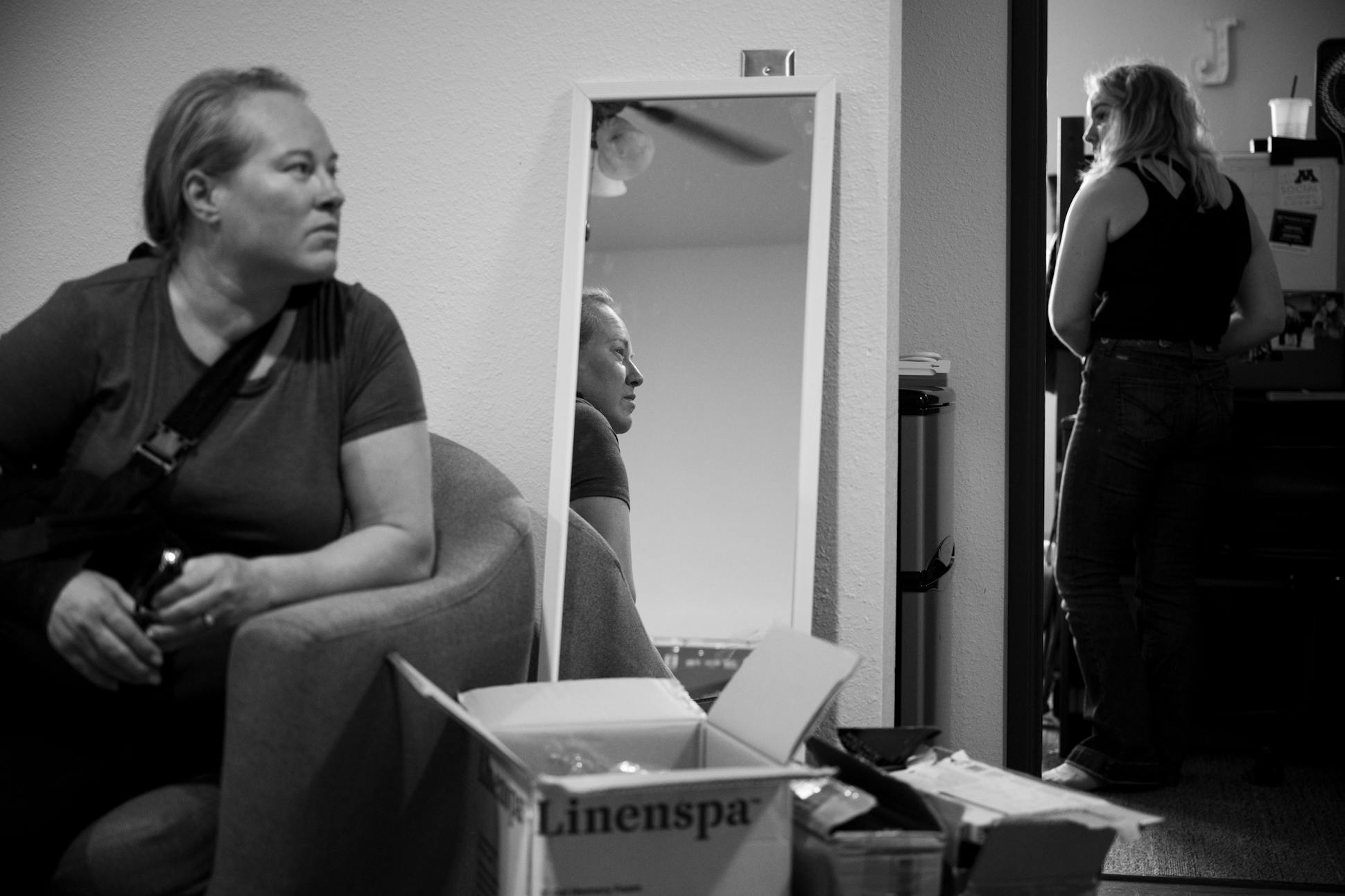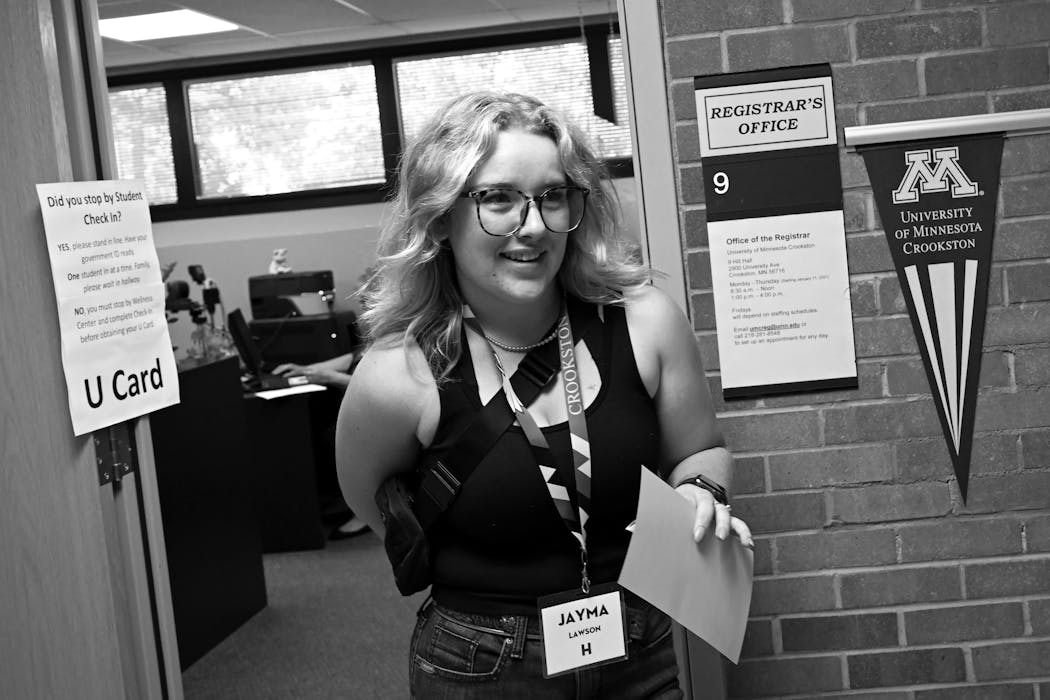In Harm's Way
This four-part series explores how Minnesota’s child protection system failed to save some of the state’s most vulnerable residents.
The first blow from her stepfather — a slap across the face — landed when Jayma Lawson was 3 or 4.
Over the next nine years, she suffered dozens of attacks, ranging from bruising spankings to sexual abuse.
She told her mother, who didn't believe her. She told her grandparents, her therapist and a school counselor. At least some of those reports were shared with authorities. But many of those claims went unchecked for years.
"I know what it feels like when you are not heard by the people who are supposed to protect you," said Jayma, who is now 18 and attending her first year of college.
Altogether, there were 41 reports of abuse and neglect involving Jayma and her two siblings between 2004 and 2021, court records show. Just seven of them led to investigations.
More than half resulted in no action or were referred to Family Assessment, an alternative pathway that is supposed to be reserved for situations that don't pose a "substantial" threat to a child's safety.
The use of Family Assessment has been controversial since 2014, when a Star Tribune report showed that Minnesota was failing to take action on an unusually high percentage of child abuse reports. Despite promises to address the problem by state officials, county workers continue to investigate just one-third of maltreatment reports.
The rest that require action end up in Family Assessment, which is both less rigorous and cheaper than an investigation, records and interviews show.
Family Assessment can help parents when they accept offers of county services, such as drug counseling. But Minnesota's heavy reliance on this less punitive intervention also allows some abusers to escape consequences for their actions. A Star Tribune review of more than 1,000 child protection cases filed in the past five years shows dozens of families like Jayma's repeatedly cycle through the program, increasing the risk that abuse will continue — or even turn deadly.
In Hennepin County, workers sent a report to Family Assessment when a mother got into a car accident with her 2-year-old daughter after drinking five shots of vodka, court records show. The girl died eight months later when her mother left her in the care of her 17-year-old boyfriend, who kicked the child to death. Workers blamed the mother for failing to protect her child.
Other reports have been referred to Family Assessment after parents have punched, choked and dragged their children by their hair, records show. In 22 cases in which parents were wholly or partly blamed for a child's death, county workers assigned at least one prior report of abuse or neglect to Family Assessment, sometimes within months of the fatality, court records show.
State law specifically excludes sexual abuse reports from Family Assessment. But state regulators discovered at least 183 reports involving suspected sexual abuse were wrongly steered to Family Assessment since 2015, when Minnesota began conducting spot checks of the program.
Former state Sen. Jane Ranum, who helped usher in the first use of Family Assessments in 2000, said she is "sickened" by widespread misuse of the program.
"It was always designed for cases that were low-risk," Ranum said. "It was not designed for people who are constantly coming into the system."
Some veteran child protection workers and others who study the system say no more than a third of credible abuse and neglect reports should be funneled into Family Assessment. Yet, the percentage of Minnesota reports referred is nearly twice that number, having grown from nearly 47% in 2005 — when the program became available statewide — to 65% in 2022.
State officials are not troubled by that increase.
"I don't think there is a right number," said Nikki Farago, a deputy commissioner at the Minnesota Department of Human Services (DHS), which oversees child protection efforts in the state. "I think we start to lose sight of what we're really doing if we just focus on the numbers. We really need to be focusing on the families and their individual needs."
In 2015, a state task force recommended sweeping changes to Minnesota's child protection system, including that DHS establish "explicit criteria" defining how low- and moderate-risk reports can be sent to Family Assessment. Those suggestions were not put into state law, though department officials say they tried to meet the intent of the recommendation by offering "clearer guidance" to child care workers.
Judith Rycus, an Ohio consultant who has worked with government agencies around the world on child protection issues, said the data shows Minnesota is sending far too many high-risk reports to Family Assessment without gathering enough information to make informed decisions.
"They don't do the in-depth risk assessments to determine whether those kids are safe or not," said Rycus, who ran Ohio's child welfare training program for decades. "They don't ask the hard questions because the ideology says that is not family-friendly. … That is when kids can be seriously harmed or die."
A cycle of abuse
For Jayma's family, the reports started in 2004, when Jayma's older sister was left alone in her crib for an unknown period of time. The report sparked no action.
The first report alleging sexual abuse was filed in 2009. It was screened out. So was a report when her sister's mouth was taped shut for screaming.
In 2011, Todd County sent a report to Family Assessment after Jayma's stepfather allegedly kicked her 2-year-old brother in the back, causing him to "fly up off the ground and into the door," records show. Nine of the 15 reports involving Jayma's family that were sent to Family Assessment involved alleged physical abuse, records show, including Jayma's brother being shot in the neck with a BB gun.
Several states, including Oregon and Louisiana, have discontinued their use of programs such as Family Assessment because of child safety issues, a lack of data showing effectiveness or other concerns, according to a 2019 report from a research group affiliated with the nonprofit American Professional Society on the Abuse of Children.
Many child protection workers defend Family Assessment because it offers a "gentler" approach to nervous parents, who may be more open to accepting service recommendations if county workers are not poised to take their children away.
By law, Family Assessment avoids assigning blame for maltreatment. That means some parents don't have to worry about a negative report impacting their employment if they work in a field licensed by DHS or the Minnesota Department of Health, including health care and social services.
There is no statutory limit to the number of times a single family can go through Family Assessment. Brad Vold, who oversaw child protection efforts in Morrison County for 12 years before taking a job in the private sector this year, said he doesn't believe there should be one.
"If we partner with families, instead of telling them what to do, they are more likely to make changes," Vold said. "I think Family Assessments can improve that relationship between the family and the county."
In a typical Family Assessment case, workers meet with parents to assess their needs. If workers see a need for services, such as anger management therapy, they can recommend that to the caregivers, who can reject those recommendations without consequences, records and interviews show.
An investigation, by contrast, is far more intrusive, with witnesses — including children — often questioned separately as workers try to determine what happened and who is to blame for any maltreatment. Parents can still reject any service recommendations, but child protection workers say it is far more likely that a county will seek protective custody of the children if caregivers refuse to cooperate, triggering court battles that usually last for months.
In 2020, nearly 5,000 alleged victims of maltreatment whose cases were handled through Family Assessment were reported for additional abuse or neglect within 12 months. That worked out to 1 out of 5 alleged victims, a higher rate than children whose families went through an investigation, state records show. Comparable figures were not included in the 2021 report.
Two former supervisors of child protective services in metro-area counties said DHS officials pressured them to send more reports to Family Assessment than they considered appropriate. They said the use of Family Assessment can save counties money because it requires significantly fewer staff resources than traditional investigations.
"You can get more work done by fewer staff," said one former metro supervisor, who spoke on the condition of anonymity.
"I am not a proponent of Family Assessment," the former supervisor added. "You don't get the same quality of information."
Rick Morrissey, who retired as a child protection supervisor in Dakota County in 2020, said state regulators would question his decision to investigate abuse and neglect reports and encourage him to send more reports to Family Assessment.
Morrissey said his bosses in Dakota County also directed him to get his Family Assessment numbers up, which he opposed.
"The feeling was out there that the more you did, the better it was," Morrissey said.
Dakota County officials declined interview requests.
Farago said she is not aware of DHS officials putting any pressure on counties to boost their use of Family Assessment.
"If that's happening, we would want to look into that and better understand what's going on," she said.
'These weren't low-risk cases'
Jayma's grandfather, Steven Betts, said he could not understand why county officials kept using Family Assessment after investigators determined that Jayma's parents each committed five acts of maltreatment in 2006.
"These weren't low-risk cases," said Betts, who tried to obtain custody of Jayma and her siblings. "These were high-risk cases."
Jayma's parents lost custody of one sibling in 2014, after her birth father was arrested on drug charges and police found multiple bruises in various stages of healing on her body. The girl, who is mentally disabled, remained in foster care until she turned 18 in 2020.
Jayma said her stepfather began sexually abusing her when she was 6. She said it continued until she was 12 or 13.
The stepfather declined to comment.
Jayma's mother, Kristen Betts, said she wasn't aware of the alleged abuse by her former husband until years later. The Star Tribune is not naming the individual because he was never criminally charged.
"I didn't know how to be a good parent," said Kristen Betts, who has since patched up her relationship with her daughter. "Maybe they should have removed (my former husband) and taken the kids so I could have gotten the help I needed at that time. But they didn't."
Jayma was removed from her parents' home in 2017. She returned 10 months later, after her stepfather began receiving therapy.
Jayma tried killing herself in 2019 and 2020.
"I felt like everything was my fault," she said.
Rycus said the case involving Jayma's family shows the need for tighter limits on the use of Family Assessment. In the past five years, up to 20% of all cases handled through Family Assessment in Minnesota had a high risk of future maltreatment, state records show.
In Jayma's case, prior findings of abuse should have barred subsequent Family Assessment referrals, Rycus said: "That's potentially dangerous."
Officials in Todd and Wadena counties, who handled all but two of the 41 reports involving Jayma's family, declined interview requests.
Jennifer Westrum, who oversees child protection efforts in Wadena County, said in a written response that Star Tribune reporting on Family Assessment practices will "allow for growth and change within our system. No system is perfect and it is only through constructive feedback, review of past practices and the implementation of best practices that the children in our state will be as safe as possible."
Lasting impact of trauma
Children who are left in the hands of abusive parents often suffer from trauma and require significant mental health services, according to a Star Tribune review of hundreds of child protection cases.
Iris Docken was 12 when she died by suicide in 2016. Her father, Dwight Docken, sued Carver County, arguing his daughter's suicide occurred because workers failed to properly respond to 27 reports of abuse and neglect involving Iris and her sisters over a 15-year period. At least five of the reports went to Family Assessment, records show.
"When I complained, nothing got done," said Docken, who did not live with his children.
In its answer to the lawsuit, Carver County officials denied wrongdoing and said they provided the "appropriate level of services" to Docken's children. The case is pending.
Jayma's brother is still struggling. He was removed from his parents' care in 2021 after a series of mental health crises, including one in which he was handcuffed to a chair by his mother. The 14-year-old boy was later hospitalized after trying to stab his foster parent and burn the house down, court records show.
Jayma said she didn't recover from her depression until she moved out of her mother's home in Staples, Minn., and went to live with a friend in 2020, when she was 15. She got involved in her local National FFA Organization chapter and was voted Minnesota's Miss U.S. Agriculture in 2023. She is now attending her first year of college at the University of Minnesota Crookston.
"I think if I had been placed with my grandparents, I could have lived a normal life," said Jayma, who plans on becoming a teacher. "But this is my past — it is definitely not going to be my future."
Former staff writer Chris Serres contributed to this report.
About the project
In Harm's Way explores how Minnesota's child protection system fails to save some of the state's most vulnerable residents. Reporters began investigating in the wake of the 2022 death of Eli Hart, who was killed by his mother after being put back in her care.
To report on this topic, Star Tribune journalists spent more than a year examining thousands of documents, starting with more than 900 death certificates, dating back to 2011, that they cross-referenced with court records of child protection cases. Altogether, the reporters reviewed more than 1,000 child protection cases and dozens of related criminal cases statewide. They supplemented that information with data from state and federal reports on the child protection system.
To learn more about the individual cases, the Minnesota child protection system and best practices, reporters contacted hundreds of people, including families, social workers, guardians and state officials.
NOTE: An earlier version of this story misstated which county sent a report to Family Assessment after a mother got into a car accident with her 2-year-old daughter after drinking five shots of vodka. It was Hennepin County. Crow Wing County referred another report about the same mother to Family Assessment four years later.
Credits
Reporting Jeffrey Meitrodt, Jessie Van Berkel, MaryJo Webster & Chris Serres
Photography Aaron Lavinsky
Photo editing Nicole Gutierrez, Emily Johnson & Katie Rausch
Digital design Dave Braunger
Graphics Yuqing Liu
Editing Katie Humphrey & Eric Wieffering
Copy editing Adelie Bergström & Catherine Preus
Digital engagement Sara Porter, Nancy Yang, Amanda Anderson & Jenni Pinkley
How to get help
People can find mental health information and resources for crisis care on NAMI Minnesota's website, namimn.org. If you or someone you know is struggling with suicidal thoughts, call the 988 Suicide and Crisis Lifeline by dialing 988. You can also text HOME to 741741 to connect with a Crisis Text Line counselor.
If you or someone you know is in an abusive relationship, contact the Day One Hotline by calling 866-223-1111 or texting 612-399-9995.
If you suspect child abuse, report it to the county where the child lives. Contact information is at tinyurl.com/3bkwukax.
Contact us
The Star Tribune is continuing to report on Minnesota's child protection system. We would like to hear from families, social workers, judges, guardians ad litem and others who have been involved in child protection. Our reporters will not share your information without your permission. You can reach Jeffrey Meitrodt at 612-673-4132 or jeff.meitrodt@startribune.com. Jessie Van Berkel is at 651-925-5044 or jessie.vanberkel@startribune.com. If you'd like to submit a letter or commentary about this story or series, use this link.











